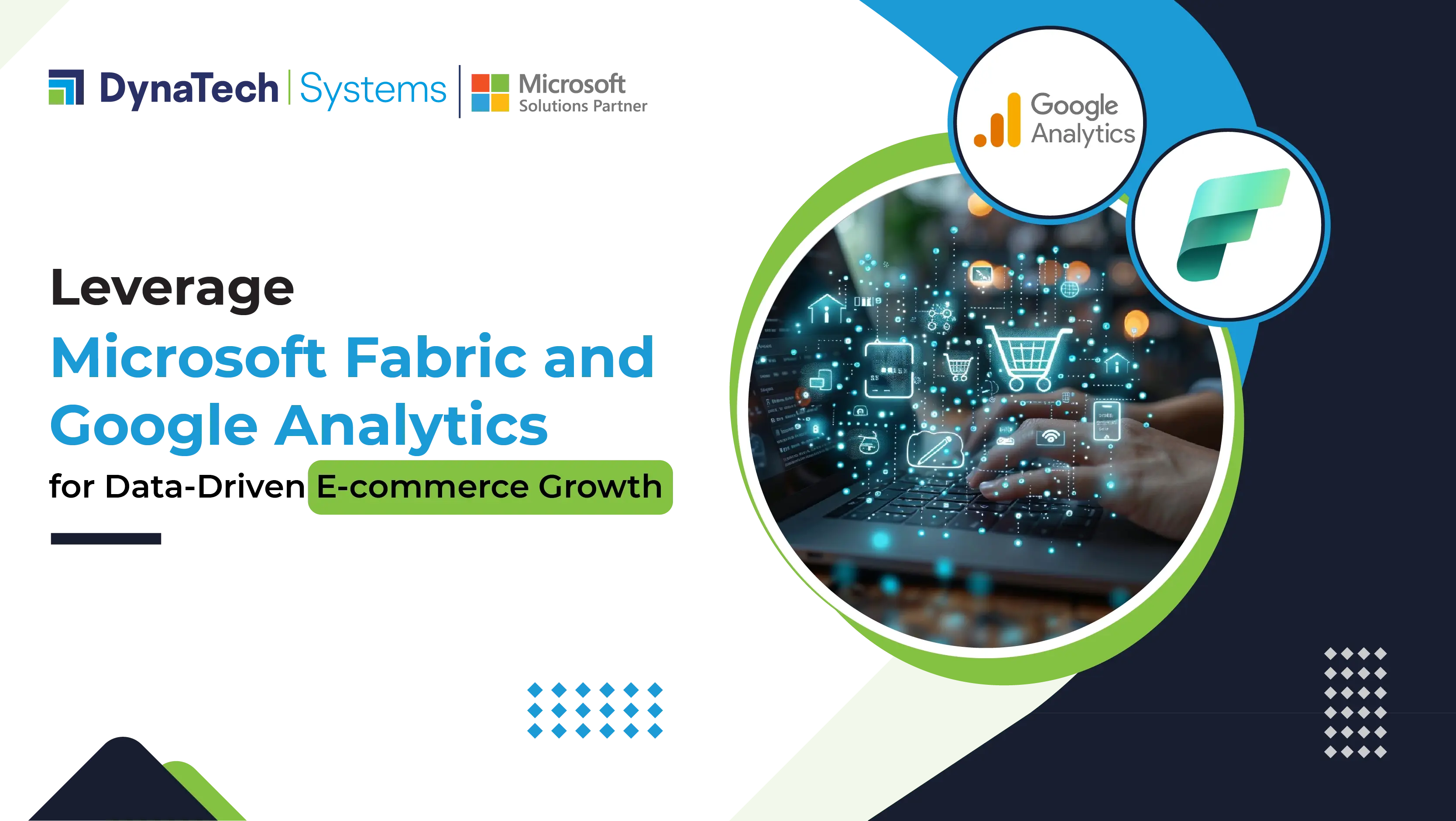E-commerce businesses thrive on data, and the ability to effectively harness and analyze this data can be the difference between success and stagnation. The intersection of E-commerce and analytics has evolved dramatically, with tools like Google Analytics becoming indispensable for understanding consumer behavior and driving sales. However, the landscape is undergoing a transformation with the advent of unified analytics platforms like Microsoft Fabric.
This blog delves into the intricacies of utilizing Microsoft Fabric for E-commerce analytics, offering a comprehensive guide for experts seeking to maximize their data insights.
Understanding the Synergy: E-commerce, Google Analytics, and Microsoft Fabric
E-commerce is a dynamic ecosystem where data-driven decisions are paramount. Understanding customer behavior, product performance, and marketing effectiveness is crucial for driving growth.
Google Analytics is the center of digital analytics, providing comprehensive insights into website traffic, user behavior, and conversions. Its rich data set is invaluable for E-commerce businesses.
Microsoft Fabric is a unified analytics platform that seamlessly integrates data from various sources, including Google Analytics. It renders a comprehensive suite of tools for data ingestion, transformation, modeling, and visualization, empowering businesses to derive actionable insights.
Why Integrate E-commerce Data with Google Analytics in Microsoft Fabric?
|
Feature |
Description |
|
Centralized Data Management |
Microsoft Fabric allows businesses to centralize their E-commerce and analytics data, facilitating easier management and access. |
|
Enhanced Data Analysis |
Google Analytics' robust data analysis capabilities combined with Microsoft Fabric's powerful data integration tools enable comprehensive analyses. |
|
Real-time Insights |
Microsoft Fabric's real-time data processing capabilities provide timely insights, crucial for quick and informed decisions. |
|
Scalability |
As businesses grow, Microsoft Fabric scales seamlessly, ensuring continued efficiency and performance. |
Setting Up Google Analytics Integration in Microsoft Fabric
Integrating Google Analytics with Microsoft Fabric involves several steps:

Step 1: Access Google Analytics Data
First, access your Google Analytics data through the Google Analytics API. You should create a project in the Google Cloud Console and enable the Google Analytics API. Obtain the necessary credentials to authenticate and access the data.
Step 2: Configure Microsoft Fabric
In Microsoft Fabric, configure a data pipeline to ingest data from Google Analytics. Use Azure Data Factory in Microsoft Fabric or a similar ETL tool to extract data from Google Analytics and load it into Microsoft Fabric.
Step 3: Data Transformation
Once the data is ingested, use Microsoft Fabric's data transformation capabilities to clean, normalize, and enrich the data. This step ensures that the data is ready for analysis and visualization.
Step 4: Data Analysis and Visualization
With the data transformed and loaded into Microsoft Fabric, use Power BI or other data visualization tools to create dashboards and reports. These visualizations provide insights into E-commerce performance, customer behavior, and other key metrics.
Building a Robust Data Model
Once the data is ingested and transformed, creating a well-structured data model is necessary. A scalable data model is essential for handling the growing volume and complexity of e-commerce data. Microsoft Fabric provides the tools and capabilities needed to build a robust and scalable e-commerce data model. Here are the key components and best practices:

Data Modeling Techniques
- Dimensional Modeling: This technique involves organizing data into fact and dimension tables. Fact tables store quantitative data such as sales and revenue, while dimension tables contain descriptive attributes like product categories and customer demographics. Dimensional modeling simplifies data queries and improves performance.
- Entity-Relationship Modeling (ERM): ERM focuses on defining the relationships between entities such as customers, products, and orders. This approach helps in designing a normalized database schema that reduces data redundancy and ensures data integrity.
- Star Schema and Snowflake Schema: The star schema is a common data modeling technique in e-commerce, where a central fact table is connected to multiple dimension tables. The snowflake schema is a more normalized version of the star schema, where dimension tables are further divided into sub-dimension tables. Both schemas are effective in organizing e-commerce data for analytical purposes.
Key Metrics for E-commerce Analysis
When analyzing E-commerce data with Google Analytics in Microsoft Fabric, focus on the following key metrics:

- Traffic Sources: Know where your visitors are coming from, including organic search, paid search, social media, and direct traffic.
- Conversion Rates: Measure visitors' percentage who complete a desired action. For instance, making a purchase or signing up for a newsletter.
- Customer Lifetime Value (CLV): Estimate the total value a customer brings to your E-commerce business over their entire relationship with you.
- Average Order Value (AOV): Calculate the average amount spent by customers per order.
- Cart Abandonment Rate: Keep a track on the total percentage of visitors who add items to their cart but are not able to complete the purchase.
- Bounce Rate: Measure the percentage of visitors who leave or abandon your site just after viewing only one page.
Leveraging Microsoft Fabric for E-commerce Insights
Microsoft Fabric renders a rich set of tools to analyze and visualize E-commerce data:
- Dataflow: For data preparation and transformation.
- One Lake: For unified data storage.
- Power BI: For interactive visualizations and reporting.

*This is an E-commerce Analytics Dashboard from Microsoft Fabric Community Themes Gallery
Advanced Analytics with Google Analytics and Microsoft Fabric
Integrating Google Analytics with Microsoft Fabric enables advanced analytics capabilities for e-commerce businesses. Here are some key applications:
1. Customer Journey Analysis
Understanding the customer journey is very important for optimizing the user experience and increasing conversions. By integrating Google Analytics data with Microsoft Fabric, businesses can analyze the complete customer journey across multiple touchpoints. This integration allows for:
- Path Analysis: Identify the most common paths that customers take on the website, from entry to conversion. Use Sankey diagrams to visualize these paths and identify drop-off points.
- Cohort Analysis: Analyze the behavior of customer cohorts based on their acquisition date. Track metrics such as retention rate, repeat purchase rate, and average order value over time.
2. Predictive Analytics
Predictive analytics can help E-commerce businesses anticipate future trends and make proactive decisions. Microsoft Fabric provides machine learning capabilities that can be combined with Google Analytics data to build predictive models. Applications include:
- Sales Forecasting: Use historical sales data to predict future sales trends. Build time series models to forecast sales for different product categories and regions.
- Customer Lifetime Value (CLV): Predict the lifetime value of customers based on their purchase history and behavior. Use CLV models to track high-value customers and tailor marketing strategies accordingly.
- Churn Prediction: Predict which customers are most likely to churn based on their behavior and engagement levels. Use this information to implement retention strategies and reduce churn rates.
3. Personalized Recommendations
Personalization is vital for enhancing the customer experience and increasing sales. By leveraging Google Analytics data and Microsoft Fabric's analytics capabilities, e-commerce enterprises can deliver personalized product recommendations. Key techniques include:
- Collaborative Filtering: Use collaborative filtering algorithms to recommend products to the customers based upon the preferences of similar customers. Analyze purchase history and browsing behavior to generate recommendations.
- Content-based Filtering: Recommend products based on the attributes of items that customers have interacted with. Use product features such as category, brand, and price to personalize recommendations.
- Hybrid Approaches: Blend collaborative filtering and content-based filtering to improve recommendation accuracy. Use machine learning models to optimize the recommendation system.
Optimizing Performance and Cost in Microsoft Fabric
Optimizing performance and cost is essential for ensuring the efficiency and scalability of e-commerce data analytics solutions in Microsoft Fabric. Here are some strategies:
Performance Optimization
- Query Optimization: Optimize SQL queries to reduce execution time and resource consumption. Use techniques such as indexing, query partitioning, and query caching to improve performance.
- Data Partitioning: Partition large datasets based on attributes such as date, region, or product category. Partitioning can improve query performance and reduce processing time by allowing parallel processing of data.
- Resource Management: Use resource management features in Microsoft Fabric to allocate resources efficiently. Monitor resource usage and scale resources up or down based on workload demands.
Cost Optimization
- Storage Optimization: Use cost-effective storage solutions such as Azure Blob Storage to store large volumes of data. Implement data archiving and purging strategies to manage storage costs effectively.
- Compute Optimization: Choose the appropriate compute resources based on workload requirements. Use Azure Reserved Instances or Spot Instances for cost savings on compute resources.
- Cost Monitoring: Use cost management tools to monitor and analyze resource usage and costs. Set budgets and alerts to track spending and identify opportunities for cost savings.
Conclusion
Integrating Google Analytics with Microsoft Fabric offers e-commerce businesses a powerful platform for deriving actionable insights and driving business growth.
By leveraging Azure Data Factory for data integration, building a scalable data model, creating interactive e-commerce analytics dashboards, and implementing advanced analytics with machine learning, businesses can optimize their operations, enhance customer satisfaction, and achieve significant business impact.
It's the right time to magnify the benefits of your E-commerce data!
Contact our experts today to find out how Microsoft Fabric can transform your business.




























